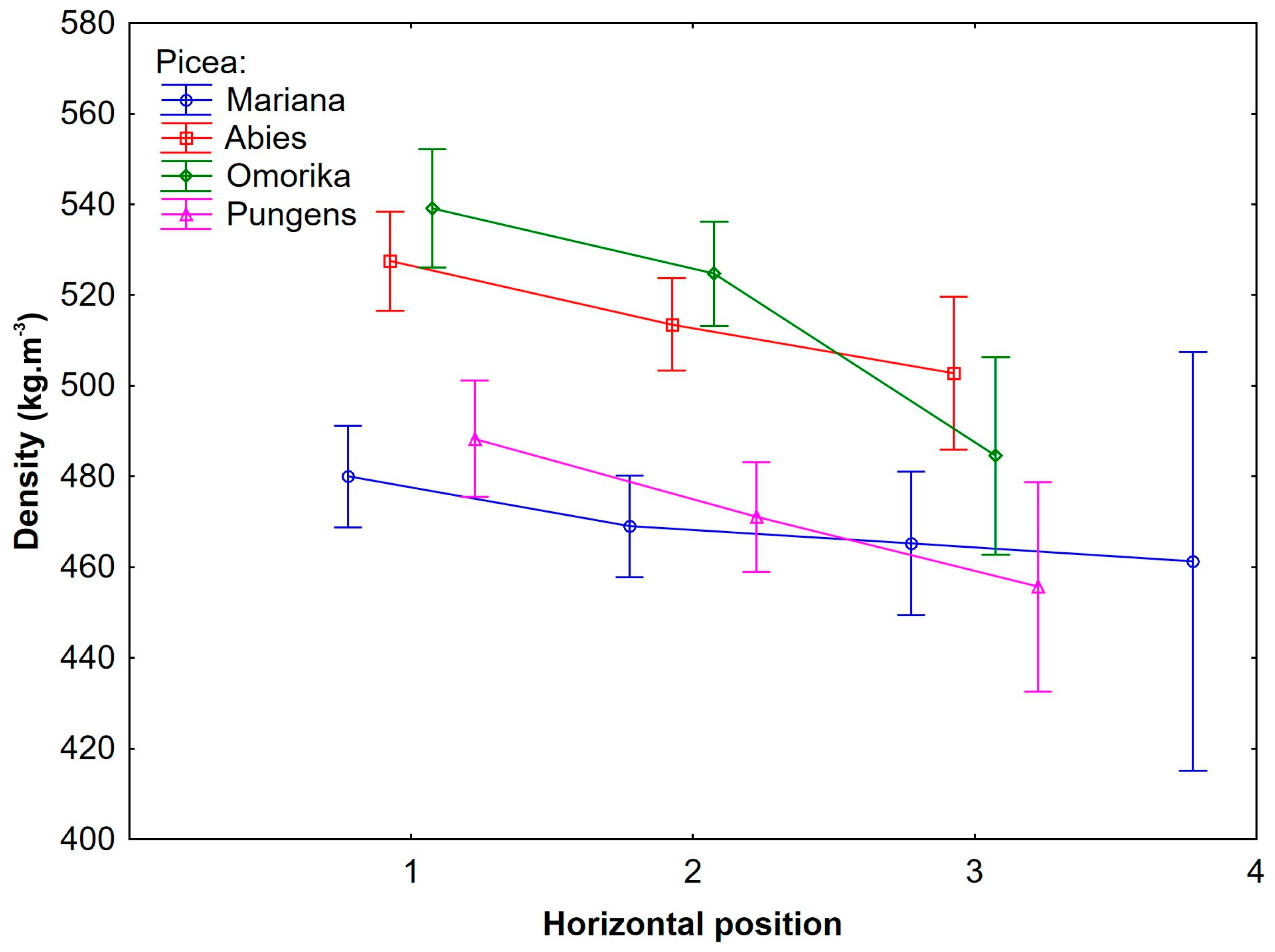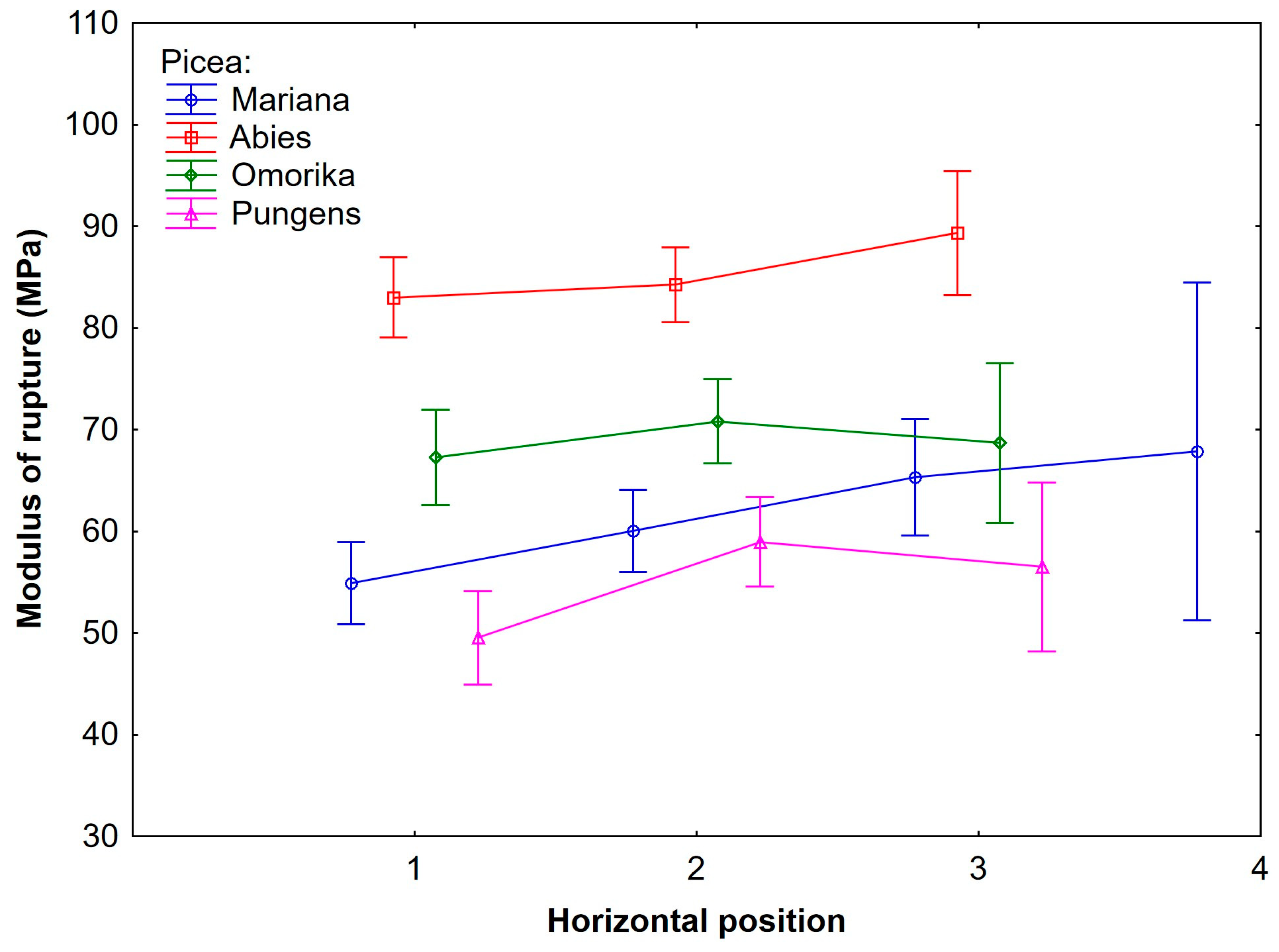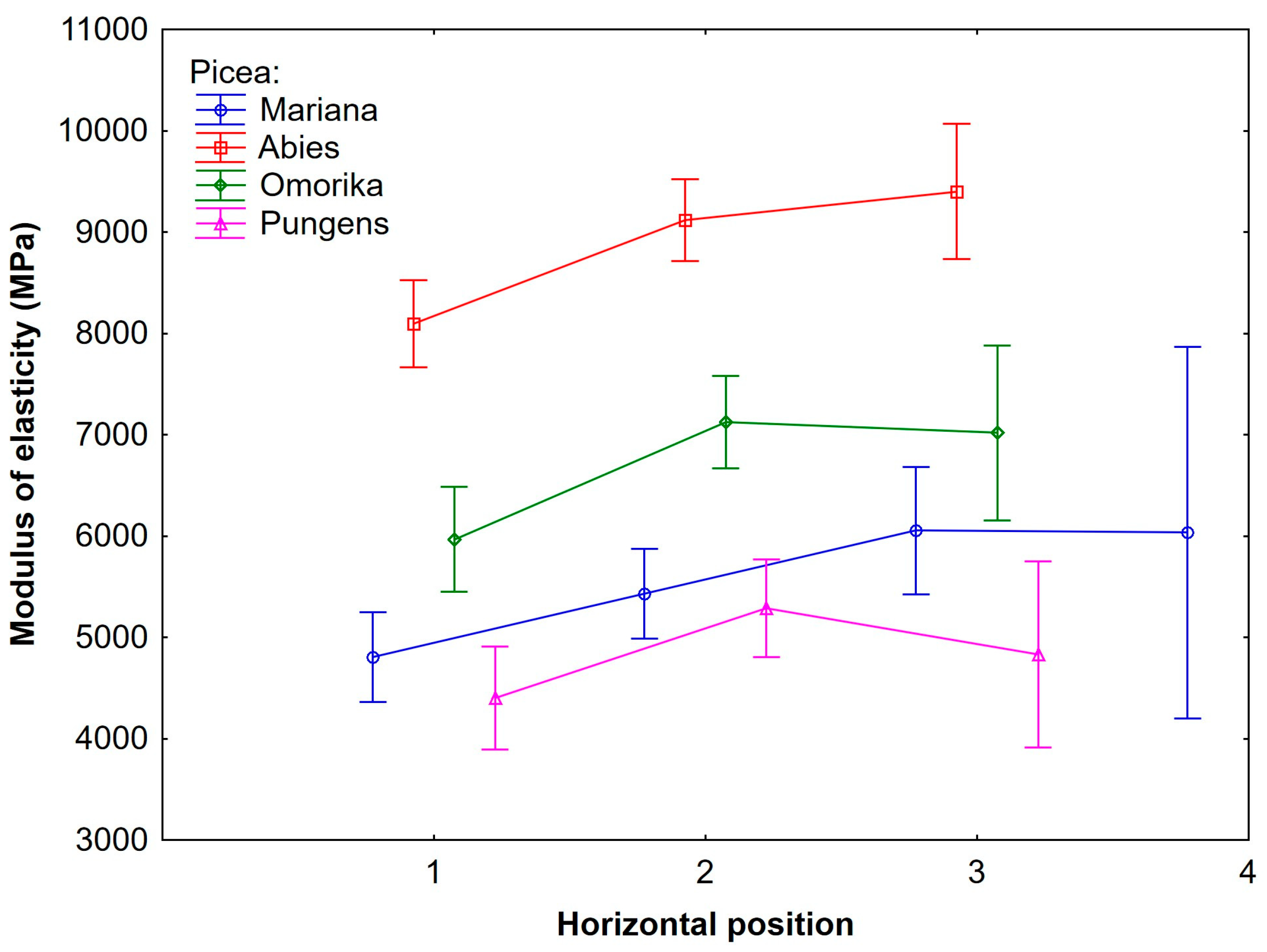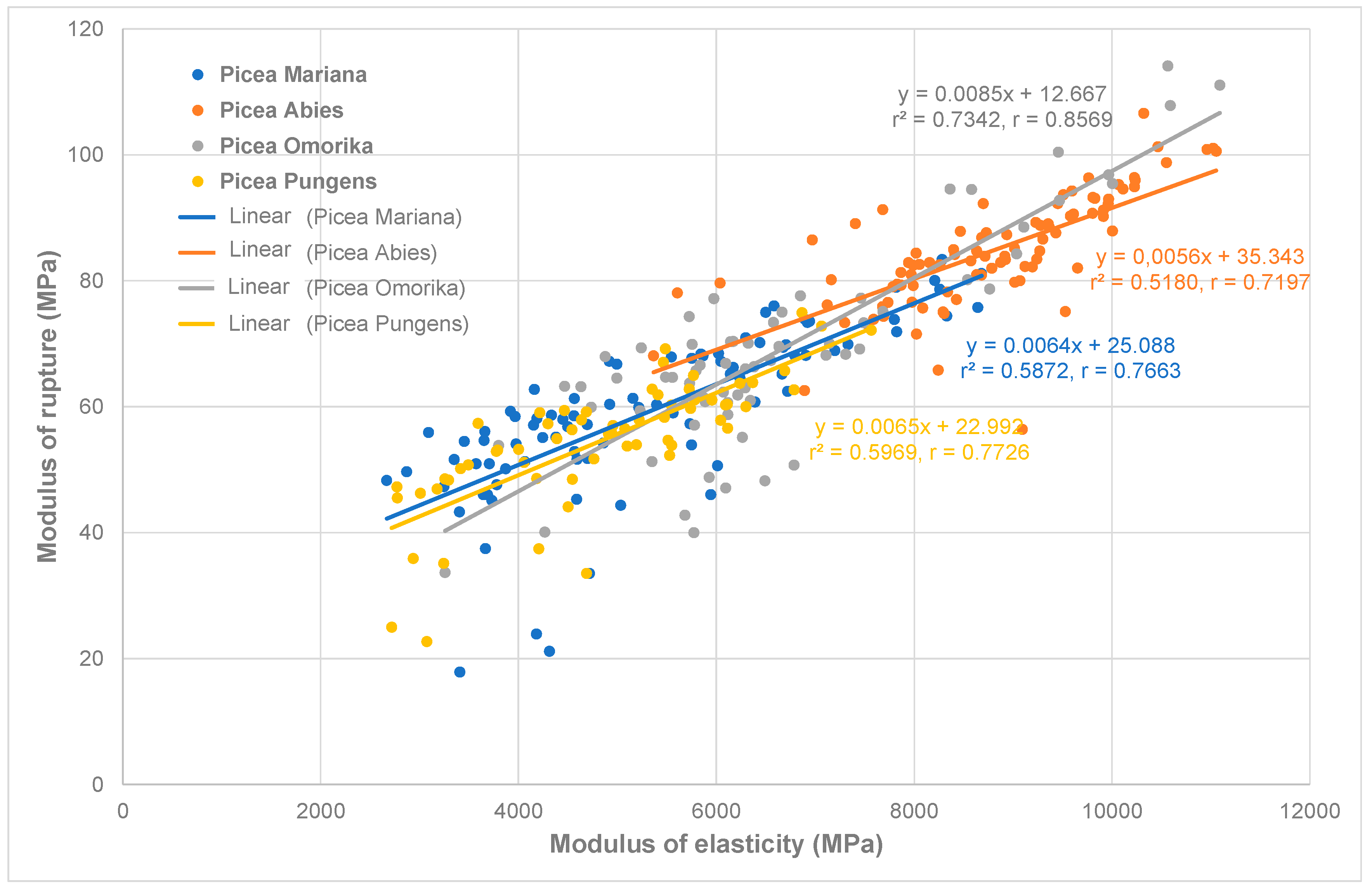The Possibility of Using Non-Native Spruces for Norway Spruce Wood Replacement—A Case Study from the Czech Republic
Abstract
:1. Introduction
2. Materials and Methods
2.1. Study Site
2.2. Data Collection and Determination of Properties
2.3. Statistical Analysis
3. Results
3.1. Wood Density
3.2. Modulus of Rupture
3.3. Modulus of Elasticity
3.4. Relationships among Tested Properties
4. Discussion
5. Conclusions
Author Contributions
Funding
Data Availability Statement
Acknowledgments
Conflicts of Interest
References
- Seidl, R.; Thom, D.; Kautz, M.; Martin-Benito, D.; Peltoniemi, M.; Vacchiano, G.; Wild, J.; Ascoli, D.; Petr, M.; Honkaniemi, J.; et al. Forest Disturbances under Climate Change. Nat. Clim. Change 2017, 7, 395–402. [Google Scholar] [CrossRef]
- Vacek, Z.; Prokůpková, A.; Vacek, S.; Cukor, J.; Bílek, L.; Gallo, J.; Bulušek, D. Silviculture as a Tool to Support Stability and Diversity of Forests under Climate Change: Study from Krkonoše Mountains. Cent. Eur. For. J. 2020, 66, 116–129. [Google Scholar] [CrossRef]
- Vacek, Z.; Vacek, S.; Cukor, J. European Forests under Global Climate Change: Review of Tree Growth Processes, Crises and Management Strategies. J. Environ. Manag. 2023, 332, 117353. [Google Scholar] [CrossRef]
- Coomes, D.A.; Flores, O.; Holdaway, R.; Jucker, T.; Lines, E.R.; Vanderwel, M.C. Wood Production Response to Climate Change Will Depend Critically on Forest Composition and Structure. Glob. Change Biol. 2014, 20, 3632–3645. [Google Scholar] [CrossRef] [PubMed]
- Berndes, G.; Abt, B.; Asikainen, A.; Cowie, A.; Dale, V.; Egnell, G.; Lindner, M.; Marelli, L.; Paré, D.; Pingoud, K.; et al. Forest Biomass, Carbon Neutrality and Climate Change Mitigation. In Proceedings of the from Science To Policy 3; Hetemäki, L., Ed.; European Forest Institute: Joensuu, Finland, 2016. [Google Scholar]
- Cukor, J.; Vacek, Z.; Vacek, S.; Linda, R.; Podrázský, V. Biomass Productivity, Forest Stability, Carbon Balance, and Soil Transformation of Agricultural Land Afforestation: A Case Study of Suitability of Native Tree Species in the Submontane Zone in Czechia. CATENA 2022, 210, 105893. [Google Scholar] [CrossRef]
- Cukor, J.; Vacek, Z.; Linda, R.; Bílek, L. Carbon Sequestration in Soil Following Afforestation of Former Agricultural Land in the Czech Republic. Cent. Eur. For. J. 2017, 63, 97–104. [Google Scholar] [CrossRef]
- Allen, C.D.; Macalady, A.K.; Chenchouni, H.; Bachelet, D.; McDowell, N.; Vennetier, M.; Kitzberger, T.; Rigling, A.; Breshears, D.D.; Hogg, E.H.; et al. A Global Overview of Drought and Heat-Induced Tree Mortality Reveals Emerging Climate Change Risks for Forests. For. Ecol. Manag. 2010, 259, 660–684. [Google Scholar] [CrossRef]
- Vacek, Z.; Bílek, L.; Remeš, J.; Vacek, S.; Cukor, J.; Gallo, J.; Šimůnek, V.; Bulušek, D.; Brichta, J.; Vacek, O.; et al. Afforestation Suitability and Production Potential of Five Tree Species on Abandoned Farmland in Response to Climate Change, Czech Republic. Trees 2022, 36, 1369–1385. [Google Scholar] [CrossRef]
- Sturrock, R.N.; Frankel, S.J.; Brown, A.V.; Hennon, P.E.; Kliejunas, J.T.; Lewis, K.J.; Worrall, J.J.; Woods, A.J. Climate Change and Forest Diseases. Plant Pathol. 2011, 60, 133–149. [Google Scholar] [CrossRef]
- Toth, D.; Maitah, M.; Maitah, K.; Jarolínová, V. The Impacts of Calamity Logging on the Development of Spruce Wood Prices in Czech Forestry. Forests 2020, 11, 283. [Google Scholar] [CrossRef]
- Šimůnek, V.; Vacek, Z.; Vacek, S. Solar Cycles in Salvage Logging: National Data from the Czech Republic Confirm Significant Correlation. Forests 2020, 11, 973. [Google Scholar] [CrossRef]
- Pötzelsberger, E.; Spiecker, H.; Neophytou, C.; Mohren, F.; Gazda, A.; Hasenauer, H. Growing Non-Native Trees in European Forests Brings Benefits and Opportunities but Also Has Its Risks and Limits. Curr. For. Rep. 2020, 6, 339–353. [Google Scholar] [CrossRef]
- Vacek, Z.; Cukor, J.; Vacek, S.; Linda, R.; Prokůpková, A.; Podrázský, V. Production Potential, Biodiversity and Soil Properties of Forest Reclamations: Opportunities or Risk of Introduced Coniferous Tree Species under Climate Change? Eur. J. For. Res. 2021, 140, 1243–1266. [Google Scholar] [CrossRef]
- Brabec, P.; Vacek, Z.; Vacek, S.; Štefančík, I.; Cukor, J.; Weatherall, A.; Gallo, J.; Slávik, M.; Sitková, Z.; Putalová, T. Growth-Climate Responses of Picea sitchensis (Bong.) Carr. versus Picea abies (L.) Karst. in the British Isles and Central Europe. Cent. Eur. For. J. 2023, 69, 167–178. [Google Scholar] [CrossRef]
- Krejza, J.; Cienciala, E.; Světlík, J.; Bellan, M.; Noyer, E.; Horáček, P.; Štěpánek, P.; Marek, M.V. Evidence of Climate-Induced Stress of Norway Spruce along Elevation Gradient Preceding the Current Dieback in Central Europe. Trees 2021, 35, 103–119. [Google Scholar] [CrossRef]
- Hlásny, T.; König, L.; Krokene, P.; Lindner, M.; Montagné-Huck, C.; Müller, J.; Qin, H.; Raffa, K.F.; Schelhaas, M.-J.; Svoboda, M.; et al. Bark Beetle Outbreaks in Europe: State of Knowledge and Ways Forward for Management. Curr. For. Rep. 2021, 7, 138–165. [Google Scholar] [CrossRef]
- Jansen, S.; Konrad, H.; Geburek, T. The Extent of Historic Translocation of Norway Spruce Forest Reproductive Material in Europe. Ann. For. Sci. 2017, 74, 56. [Google Scholar] [CrossRef]
- Caudullo, G.; Tinner, W.; de Rigo, D. Picea Abies in Europe: Distribution, Habitat, Usage and Threats. In European Atlas of Forest Tree Species; San-Miguel-Ayanz, J., de Rigo, D., Caudullo, G., Durrant, T.H., Mauri, A., Eds.; Publications Office of the European Union: Luxembourg, 2016. [Google Scholar]
- Šilinskas, B.; Varnagiryte-Kabašinskiene, I.; Aleinikovas, M.; Beniušiene, L.; Aleinikoviene, J.; Škema, M. Scots Pine and Norway Spruce Wood Properties at Sites with Different Stand Densities. Forests 2020, 11, 587. [Google Scholar] [CrossRef]
- Krajnc, L.; Farrelly, N.; Harte, A.M. The Effect of Thinning on Mechanical Properties of Douglas Fir, Norway Spruce, and Sitka Spruce. Ann. For. Sci. 2019, 76, 3. [Google Scholar] [CrossRef]
- Steiger, R.; Arnold, M. Strength Grading of Norway Spruce Structural Timber: Revisiting Property Relationships Used in EN 338 Classification System. Wood Sci. Technol. 2009, 43, 259–278. [Google Scholar] [CrossRef]
- Dinwoodie, J.M.J. Timber: Its Nature and Behaviour, 2nd ed.; Routledge: New York, NY, USA, 2000; ISBN 1135808104. [Google Scholar]
- Torquato, L.P.; Auty, D.; Hernández, R.E.; Duchesne, I.; Pothier, D.; Achim, A. Black Spruce Trees from Fire-Origin Stands Have Higher Wood Mechanical Properties than Those from Older, Irregular Stands. Can. J. For. Res. 2014, 44, 118–127. [Google Scholar] [CrossRef]
- Ivetić, V.; Aleksić, J.J.M. Response of Rare and Endangered Species Picea Omorika to Climate Change: The Need for Speed. Reforesta 2016, 2, 81–99. [Google Scholar] [CrossRef]
- Stokes, V.J.; Jinks, R.; Kerr, G. An Analysis of Conifer Experiments in Britain to Identify Productive Alternatives to Sitka Spruce. For. An Int. J. For. Res. 2023, 96, 170–187. [Google Scholar] [CrossRef]
- Petrović, D.; Dukić, V.D.; Popović, Z.; Todorović, N. MOR and MOE of Serbian Spruce (Picea Omorika Pančić/Purkyně) Wood from Natural Stands. Drv. Ind. 2021, 72, 193–200. [Google Scholar] [CrossRef]
- Kommert, R. Die Holzeigenschaften Der Serbischen Fichte Aus Anbauten Im Freistaat Sachsen. Holz Als Roh-Und Werkst. 1993, 51, 329–334. [Google Scholar] [CrossRef]
- Burns, R.M.; Honkala, B.H. Technical C. Silvics of North America. Volume 1. Conifers. In Agriculture Handbookl; US Department of Agriculture: Washington, DC, USA, 1990. [Google Scholar]
- Zhang, S.Y.; Chauret, G.; Ren, H.Q.; Desjardins, R. Impact of Initial Spacing on Plantation Black Spruce Lumber Grade Yield, Bending Properties, and MSR Yield. Wood Fiber Sci. 2002, 34, 460–475. [Google Scholar]
- Tong, Q.-J.; Fleming, R.L.; Tanguay, F.; Zhang, S.Y. Wood and Lumber Properties from Unthinned and Precommercially Thinned Black Spruce Plantations. Wood Fiber Sci. 2009, 41, 168–179. [Google Scholar]
- Vincent, M.; Krause, C.; Koubaa, A. Variation in Black Spruce (Picea mariana (Mill.) BSP) Wood Quality after Thinning. Ann. For. Sci. 2011, 68, 1115–1125. [Google Scholar] [CrossRef]
- Alteyrac, J.; Alain Cloutier, C.; Ung, C.-H.; Zhang, S.Y. Mechanical Properties in Relation to Selected Wood Characteristics of Black Spruce. Wood Fiber Sci. 2006, 38, 229–237. [Google Scholar]
- Křivánek, M.; Pyšek, P.; Jarošík, V. Planting History and Propagule Pressure as Predictors of Invasion by Woody Species in a Temperate Region. Conserv. Biol. 2006, 20, 1487–1498. [Google Scholar] [CrossRef]
- Gryc, V.; Vavrčík, H.; Kotalík, O. Selected Properties of Blue Spruce Wood from Non-Forest Land. Acta Univ. Agric. Silvic. Mendel. Brun. 2009, 52, 37–44. [Google Scholar] [CrossRef]
- Vacek, Z.; Cukor, J.; Vacek, S.; Podrázský, V.; Linda, R.; Kovařík, J. Forest Biodiversity and Production Potential of Post-Mining Landscape: Opting for Afforestation or Leaving It to Spontaneous Development? Cent. Eur. For. J. 2018, 64, 116–126. [Google Scholar] [CrossRef]
- Dimitrovský, K.; Modrá, B.; Prokopová, D. Produkční a Mimoprodukční Význam Antropogenních Substrátů Na Výsypkách Sokolovské Uhelné Pánve. Zprav. Hnědé Uhlí 2010, 4, 8–16. [Google Scholar]
- Vacek, Z.; Linda, R.; Cukor, J.; Vacek, S.; Šimůnek, V.; Gallo, J.; Vančura, K. Scots pine (Pinus sylvestris L.), the suitable pioneer species for afforestation of reclamation sites? For. Ecol. Manag. 2021, 485, 118951. [Google Scholar] [CrossRef]
- Peel, M.C.; Finlayson, B.L.; McMahon, T.A. Updated World Map of the Köppen-Geiger Climate Classification. Hydrol. Earth Syst. Sci. 2007, 11, 1633–1644. [Google Scholar] [CrossRef]
- Bublinec, E. Koncentrácia, Akumulácia a Kolobeh Prvkov v Bukovom a Smrekovom Ekosystéme; Veda: Bratislava, Slovakia, 1994; ISBN 8022401277. [Google Scholar]
- Petras, R.; Kosut, M.; Oszlányi, J. Listová Biomasa Stromov Smreka, Borovice a Buka. Lesn. Cas. 1985, 31, 323–333. [Google Scholar]
- Zeidler, A.; Borůvka, V.; Černý, J.; Baláš, M. Douglas-Fir Outperforms Most Commercial European Softwoods. Ind. Crops Prod. 2022, 181, 114828. [Google Scholar] [CrossRef]
- Zeidler, A.; Vacek, Z.; Cukor, J.; Vlastimil, B.; Vacek, S.; Prokupova, A.; Linda, R.; Vacek, O. Is European Larch (Larix decidua Mill.) a Suitable Substitute for Norway Spruce (Picea abies (L.) Karst.) for Agricultural Land Afforestation ? For. Ecol. Manag. 2022, 517, 120257. [Google Scholar] [CrossRef]
- ČSN 49 0103 Drevo; Zisťovanie Vlhkosti Pri Fyzikálnych a Mechanických Skúškach (Wood. Determination of Moisture Content at Physical and Mechanical Testing). Vydavatelství Úřadu pro Normalizaci a Měření: Prague, Czech Republic, 1979. (In Czech)
- ČSN 49 0108 Drevo; Zisťovanie Hustoty (Wood. Determination of the Density). Český Normalizační Institut: Prague, Czech Republic, 1993. (In Czech)
- ČSN 49 0115 Drevo; Zisťovanie Medze Pevnosti v Statickom Ohybe (Wood. Determination of Ultimate Strength in Flexure Tests). Vyda-Vatelství Úřadu pro Normalizaci a Měření: Prague, Czech Republic, 1979. (In Czech)
- ČSN 49 0116 Drevo; Metóda Zisťovania Modulu Pružnosti Pri Statickom Ohybe (Wood. Determination of the Modulus of Elasticity in Static Bending). Vydavatelství Úřadu pro Normalizaci a Měření: Prague, Czech Republic, 1982. (In Czech)
- Maitah, M.; Toth, D.; Malec, K.; Appiah-Kubi, S.N.K.; Maitah, K.; Pańka, D.; Prus, P.; Janků, J.; Romanowski, R. The Impacts of Calamity Logging on the Sustainable Development of Spruce Fuel Biomass Prices and Spruce Pulp Prices in the Czech Republic. Forests 2022, 13, 97. [Google Scholar] [CrossRef]
- Verkasalo, E.; Leban, J.-M. MOE and MOR in Static Bending of Small Clear Specimens of Scots Pine, Norway Spruce and European Fir from Finland and France and Their Prediction for the Comparison of Wood Quality. Pap. Ja Puu 2002, 84, 332–341. [Google Scholar]
- Wagenführ, R. Holzatlas, Wood Atlas; Fachbuchverlag: Leipzig, Germany, 2007. [Google Scholar]
- Szaban, J.; Kowalkowski, W.; Karaszewski, Z.; Jakubowski, M. Ge{ogonek}stość Umowna Drewna Świerka Pospolitego (Picea abies [L.] Karst.) Pochodza{ogonek}cego z Powierzchni Doświadczalnej Zlokalizowanej Na Terenie Leśnego Zakładu Doświadczalnego Siemianice. Drewno 2014, 191, 135–144. [Google Scholar] [CrossRef]
- Zobel, B.J.; Sprague, J.R. Timell, T.E., Ed.; Springer {Series} in {Wood} {Science}; Springer: Berlin/Heidelberg, Germany, 1998; ISBN 978-3-642-72128-1/978-3-642-72126-7.
- Bartoš, J.; Souček, J.; Kacálek, D. Comparison of Wood Properties of 50-Year-Old Spruce Stands on Sites Experiencing Different Land Use in the Past. Zpravy Lesn. Vyzk. 2010, 55, 195–200. [Google Scholar]
- Zeidler, A.; Borůvka, V.; Schönfelder, O. Comparison of Wood Quality of Douglas Fir and Spruce from Afforested Agricultural Land and Permanent Forest Land in the Czech Republic. Forests 2017, 9, 13. [Google Scholar] [CrossRef]
- Cukor, J.; Zeidler, A.; Vacek, Z.; Vacek, S.; Šimůnek, V.; Gallo, J. Comparison of Growth and Wood Quality of Norway Spruce and European Larch: Effect of Previous Land Use. Eur. J. For. Res. 2020, 139, 459–472. [Google Scholar] [CrossRef]
- Bacher, M.; Krzosek, S. Modulus of Elasticity Tension/Bending Ratio of Polish Grown Pine (Pinus sylvestris L.) and Spruce (Picea abies Karst.) Timber. Ann. Warsaw Univ. Life Sci.-SGGW. For. Wood Technol. 2013, 82, 31–38. [Google Scholar]
- Jelonek, T.; Klimek, K.; Kopaczyk, J.; Wieruszewski, M.; Arasimowicz-Jelonek, M.; Tomczak, A.; Grzywiński, W. Influence of the Tree Decay Duration on Mechanical Stability of Norway Spruce Wood (Picea abies (L.) Karst.). Forests 2020, 11, 980. [Google Scholar] [CrossRef]
- Alden, H.A. Softwoods of North America; United States Department of Agriculture: Madison, WI, USA, 1997. [Google Scholar]
- Panshin, A.J.; De Zeeuw, C. Textbook of Wood Technology, 4th ed.; McGraw-Hill: New York, NY, USA, 1964. [Google Scholar]
- Zobel, B.J.; Van Buijtenen, J.P. Wood Variation: Its Causes and Control; Springer Science & Business Media: New York, NY, USA, 2012; ISBN 3642740693. [Google Scholar]
- Rossi, S.; Cairo, E.; Krause, C.; Deslauriers, A. Growth and Basic Wood Properties of Black Spruce along an Alti-Latitudinal Gradient in Quebec, Canada. Ann. For. Sci. 2015, 72, 77–87. [Google Scholar] [CrossRef]
- Bodig, J.; Jayne, B.A. Mechanics of Wood and Wood Composites; Krieger Pub. Co.: Malabar, FL, USA, 1982. [Google Scholar]
- Madsen, B. Structural Behavior of Timber; Timber Engineering Ltd.: Dundee, UK, 1992; ISBN 0969616201. [Google Scholar]
- Shmulsky, R.; Jones, P.D. Forest Products and Wood Science An Introduction; Wiley: Hoboken, NJ, USA, 2011; ISBN 9780813820743. [Google Scholar]
- Kollmann, F.F.P.; Côté, W.A. Principles of Wood Science and Technology; Springer: Berlin/Heidelberg, Germany, 1968; ISBN 978-3-642-87930-2. [Google Scholar]
- Rodríguez y Silva, F.; Ramón Molina, J.; González-Cabán, A.; Machuca, M.Á.H. Economic Vulnerability of Timber Resources to Forest Fires. J. Environ. Manag. 2012, 100, 16–21. [Google Scholar] [CrossRef] [PubMed]
- Vakula, J.; Zúbrik, M.; Galko, J.; Gubka, A. Influence of Selected Factors on Bark Beetle Outbreak Dynamics in the Western Carpathians. Lesn. Cas. For. J. 2015, 61, 149–156. [Google Scholar] [CrossRef]
- FAO. Global Forest Resources Assessment 2000 (FRA 2000); Food and Agricultural Organization of the United Nations: Rome, Italy, 2000. [Google Scholar]
- FAO. The State of the World’s Forests 2022; FAO: Rome, Italy, 2022; ISBN 978-92-5-135984-6. [Google Scholar]
- Dyderski, M.K.; Paź, S.; Frelich, L.E.; Jagodziński, A.M. How Much Does Climate Change Threaten European Forest Tree Species Distributions? Glob. Change Biol. 2018, 24, 1150–1163. [Google Scholar] [CrossRef]
- Frischbier, N.; Nikolova, P.S.; Brang, P.; Klumpp, R.; Aas, G.; Binder, F. Climate Change Adaptation with Non-Native Tree Species in Central European Forests: Early Tree Survival in a Multi-Site Field Trial. Eur. J. For. Res. 2019, 138, 1015–1032. [Google Scholar] [CrossRef]





| Species | Altitude | Exposure | Slope | DBH | Height | Stem Volume | Tree Density | Basal Area | Stand Volume | Carbon Stock |
|---|---|---|---|---|---|---|---|---|---|---|
| (cm) | (m) | (m3) | (trees·ha−1) | (m2·ha−1) | (m3·ha−1) | (t·ha−1) | ||||
| P. abies | 432 | - | 0 | 14.3 | 13.8 | 0.122 | 1733 | 28.5 | 189 | 76.7 |
| P. mariana | 428 | S | 4 | 11.2 | 11.1 | 0.048 | 1733 | 17.0 | 83 | 40.3 |
| P. omorika | 433 | - | 0 | 19.9 | 14.0 | 0.186 | 1080 | 32.5 | 195 | 79.6 |
| P. pungens | 441 | SE | 6 | 14.8 | 10.9 | 0.089 | 1267 | 22.9 | 116 | 50.6 |
| Mean | Min. | Max. | SD | CV | ||
|---|---|---|---|---|---|---|
| Black spruce | 468 a | 406 | 533 | 28 | 5.9 | Test |
| Norway spruce | 517 b | 457 | 583 | 31 | 6.0 | ANOVA |
| Serbian spruce | 525 b | 427 | 646 | 51 | 9.7 | p-value |
| Blue spruce | 476 a | 425 | 543 | 25 | 5.3 | p < 0.001 |
| Mean | Min. | Max. | SD | CV | ||
|---|---|---|---|---|---|---|
| Black spruce | 57.2 a | 17.9 | 83.4 | 12.1 | 21.2 | Test |
| Norway spruce | 84.6 c | 56.4 | 106.6 | 8.8 | 10.4 | ANOVA |
| Serbian spruce | 69.2 b | 33.6 | 114.1 | 16.4 | 23.8 | p-value |
| Blue spruce | 54.8 a | 22.7 | 74.9 | 10.1 | 18.4 | p < 0.001 |
| Mean | Min. | Max. | SD | CV | ||
|---|---|---|---|---|---|---|
| Black spruce | 5107 a | 2667 | 8681 | 1548 | 30.3 | Test |
| Norway spruce | 8764 c | 5364 | 11053 | 1122 | 12.8 | ANOVA |
| Serbian spruce | 6670 b | 3257 | 11090 | 1663 | 24.9 | p-value |
| Blue spruce | 4863 a | 2718 | 7565 | 1193 | 24.5 | p < 0.001 |
Disclaimer/Publisher’s Note: The statements, opinions and data contained in all publications are solely those of the individual author(s) and contributor(s) and not of MDPI and/or the editor(s). MDPI and/or the editor(s) disclaim responsibility for any injury to people or property resulting from any ideas, methods, instructions or products referred to in the content. |
© 2024 by the authors. Licensee MDPI, Basel, Switzerland. This article is an open access article distributed under the terms and conditions of the Creative Commons Attribution (CC BY) license (https://creativecommons.org/licenses/by/4.0/).
Share and Cite
Zeidler, A.; Borůvka, V.; Brabec, P.; Tomczak, K.; Bedřich, J.; Vacek, Z.; Cukor, J.; Vacek, S. The Possibility of Using Non-Native Spruces for Norway Spruce Wood Replacement—A Case Study from the Czech Republic. Forests 2024, 15, 255. https://doi.org/10.3390/f15020255
Zeidler A, Borůvka V, Brabec P, Tomczak K, Bedřich J, Vacek Z, Cukor J, Vacek S. The Possibility of Using Non-Native Spruces for Norway Spruce Wood Replacement—A Case Study from the Czech Republic. Forests. 2024; 15(2):255. https://doi.org/10.3390/f15020255
Chicago/Turabian StyleZeidler, Aleš, Vlastimil Borůvka, Pavel Brabec, Karol Tomczak, Jakub Bedřich, Zdeněk Vacek, Jan Cukor, and Stanislav Vacek. 2024. "The Possibility of Using Non-Native Spruces for Norway Spruce Wood Replacement—A Case Study from the Czech Republic" Forests 15, no. 2: 255. https://doi.org/10.3390/f15020255









